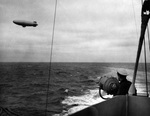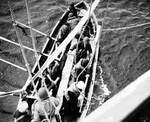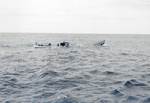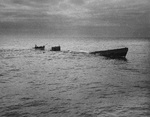Black May
Contributor: C. Peter Chen
ww2dbaseThe German Navy was successful in hunting Allied shipping in the Altantic Ocean in the month of Mar 1943, sinking more than 70 ships. Although German submarine activity decreased in Apr 1943 as many of the submarines active in Mar were back in their home ports for repairs and replenishment, the month still saw more than 30 sinkings of Allied ships in the Atlantic Ocean. In May 1943, however, the table completely turned in favor of the Allies. Between 29 Apr and 6 May, German submarines attacked Allied convoy ONS 5 in the North Atlantic, sinking 12 ships; however, the convoy's escorts were able to sink 6 submarines and damage 7 others, making it the first convoy to inflict heavy damage among the attacking wolfpack. Later in the month, Allied convoy SC 130 was unsuccessfully attacked with the loss of 5 submarines. Although May 1943 represented the month in which German Navy had its greatest strength of operational submarines (240 total; 118 on patrol at sea during this month), it was only able to sink about 30 Allied ships in the Atlantic Ocean, meaning that the German Navy was only able to maintain the low rate of sinking from the previous month rather than improving it. This alarmed German Admiral Karl Dönitz, who scaled back submarine operations on 24 May in order to regroup and re-evaluate tactics. The Allies would attribute their success to increased number of vessels available for escort duties and technological advances in anti-submarine weaponry.
ww2dbaseThe German submarines would never regain the level of success it previously achieved.
ww2dbaseSource: Wikipedia
Last Major Update: May 2011
Black May Interactive Map
Photographs
 |  |  |  |
Black May Timeline
| 12 Mar 1943 | In the Atlantic Ocean, the drifting wreck of the Liberty Ship Thomas Hooker (suffered structural damage during a hurricane before dawn on 6 Mar 1943; crew abandoned ship and took to the boats) was located by German submarine U-653 (Kapitänleutnant Gerhard Feiler) which hit her with two torpedoes at 0209 hours and 0433 hours. The ship sank by the stern two minutes after the second torpedo hit. |
| 12 Mar 1943 | The U-130 (Oberleutnant zur See Siegfried Keller) was sunk in the Atlantic Ocean west of the Azores by depth charges from the destroyer USS Champlin (DD-601). All 53 on board were lost. |
| 21 Apr 1943 | Allied convoy ONS 5 consisted of 42 ships departed from Liverpool, England, United Kingdom for a 3-week journey to Halifax, Nova, Scotia, Canada; it was escorted by 7 warships (2 destroyers, 1 frigate, and 4 corvettes) and supported by 2 trawlers and 1 tanker. The convoy was under the command of J. Kenneth Brook of the British Royal Navy Reserve; he was aboard Norwegian freighter Rena. The convoy was to grow in size from mid-journey rendezvous with other ships departing from other ports. |
| 24 Apr 1943 | In the North Atlantic, Escorts of Allied convoy ONS 5 spotted and sank German submarine U-710 10 miles ahead of the convoy. |
| 27 Apr 1943 | Admiral Dönitz issued a new order to his submarine commanders, instructing that they were to cross the Bay of Biscay submerged during the night and to resurface during the day only long enough to recharge their batteries. This proved something of a mistake for the Germans as it permitted some 12 RAF Squadrons to contribute to daylight anti-submarine operations. |
| 28 Apr 1943 | German submarine U-650 sighted Allied convoy ONS 5 in the North Atlantic at 0800 hours. During the day U-375, U-386, U-528, and U-537 sailed toward U-650 and began planning the attack. Radio chatter between these submarines alerted commander of ONS 5 escorts Captain Peter Gretton. |
| 29 Apr 1943 | Starting at midnight, German submarines U-650, U-375, U-386, U-528, and U-532 attacked Allied convoy ONS 5 in the North Atlantic. They scored no hits until around 1200 hours when US freighter McKeesport sunk by a torpedo from U-528; three attacking submarines were damaged during the attacks and were forced to return to base to receive repairs. Upon learning the attacks, the British Admiralty dispatched additional destroyers to reinforce the escort force. |
| 4 May 1943 | German submarine U-625 spotted Allied convoy ONS 5 in the North Atlantic at about 1200 hours local time. Several German submarines gathered and began attacking at dusk and lasted through the night into the next date, sinking 7 ships (British freighters L'Orient, North Britain, Harbury, Harpurley, Bristol City, and Wentworth; US freighter West Maximus). U-630 was lost during the attacks. |
| 5 May 1943 | German submarines continued to attack Allied convoy ONS 5 in the North Atlantic, sinking British freighter Dolius and US freighter West Makadet during the day; German submarine U-358 was damaged during the attacks. After dark, German submarines lost contact with the convoy, sinking British freighters Selvistan and Gharinda and Norwegian freighter Bonde, but the radar-equipped Allied escorts continued to fight back, sinking U-638, U-125, and U-531. |
| 6 May 1943 | British corvette HMS Loosestrife sank German submarine U-638 with depth charges, which was attempting to attack Allied convoy ONS 5 in the North Atlantic; two other submarines were also destroyed on this date. Realizing the convoy was now well escorted, Admiral Karl Dönitz ordered the attacks on this convoy to cease. |
| 7 May 1943 | Hitler announced in a speech to Reichsleiters and Gauleiters that submarine warfare was to be stepped up as the surest way to cut enemy supply lines, even as the German submarine fleet was being pounded in the Atlantic Ocean. |
| 7 May 1943 | Jaguar, Greif, and Möwe completed their escort mission for minelayers in the North Sea. |
| 11 May 1943 | Allied convoy SC 130 (37 ships) departed Halifax, Nova Scotia, Canada for Liverpool, England, United Kingdom. |
| 12 May 1943 | Just 17 months after the first conceptual meeting for an acoustic homing torpedo, the Mark 24 FIDO aerial torpedo had its first operational victory when a Liberator bomber of RAF Coastal Command’s 86 Squadron caught German submarine U-456 on the surface in the mid-Atlantic. As the submarine dove, the bomber dropped one Mark 24 torpedo that guided itself to the submerged submarine and exploded, causing major damage. Later that same day when U-456 was forced to dive deep to avoid a depth charge attack by destroyer HMS Opportune, the previous damage proved too great and the submarine sank with all 49 hands. |
| 14 May 1943 | The United States Navy achieved its first success with the Mark 24 FIDO acoustic homing torpedo when Lt(jg) Phillip Bodinet of Patrol Squadron VP-84 flying a PBY-5A Catalina dropped one Mark 24 torpedo against German submarine U-640 about midway between Iceland and Greenland resulting in the loss of the boat and all 49 on board. |
| 18 May 1943 | After sundown, German submarine U-304 spotted Allied convoy SC 130 in the North Atlantic. |
| 18 May 1943 | Auxiliary Aircraft Carrier USS Bogue and her task group departed Iceland and joined the escort of Convoy ON-184. |
| 19 May 1943 | In the North Atlantic, as German submarines began to form an attack formation against Allied convoy SC 130, Liberator bombers of No. 120 Squadron RAF pre-emptively struck them, breaking up the attack. The convoy was met by additional 3 frigates and 1 sloop as reinforcement. |
| 21 May 1943 | LtCdr William Drane, commanding officer of Composite Squadron VC-9, flying a TBF-1 Avenger from Auxiliary Aircraft Carrier USS Bogue attacked and damaged the German submarine U-231 in the North Atlantic. |
| 22 May 1943 | As German submarine Wolfpack Mosel of 21 boats continued its attack on North Atlantic Convoy ON-184, several aircraft flying from USS Bogue executed five different attacks against different submarines and damaged U-569 so badly that she was later scuttled by her crew along with also damaging U-305. |
| 24 May 1943 | British destroyer HMS Active (H 14), escorting Allied convoy KMF-15, sighted Italian submarine Leonardo da Vinci in the Atlantic Ocean at 1130 hours. Shortly after, frigate HMS Ness (K 219), escorting Allied convoy WS-30 which sailed together with KMF-15, also sighted her. Leonardo da Vinci submerged, and HMS Active attacked with 10 depth charges at 1143 hours. At 1150 hours, HMS Ness joined in with 10 depth charges of her own. At 1158 hours, HMS Active dropped 10 depth charges. At 1212 hours, HMS Ness dropped 10 depth charges. At 1223 hours, HMS Active dropped 10 depth charges. At 1240 hours, wreckage, life jackets, coffee tins, and human remains were observed. At 1305 hours, HMS Ness dropped 10 depth charges. Leonardo da Vinci, with her crew of 9 officers and 54 ratings, was never heard from again. |
| 24 May 1943 | After suffering many submarine sinkings during May 1943, German Admiral Karl Dönitz ordered a temporary halt to submarine operations in the North Atlantic to regroup and re-evaluate tactics. |
| 26 May 1943 | The United States Navy’s Patrol Squadron VP-84 scored another success with the Mark 24 FIDO acoustic homing torpedo south of Iceland when Lt Robert Millard dropped one Mark 24 torpedo from his PBY-5A Catalina against German submarine U-467. The U-Boat was lost with all 46 hands. |
| 26 May 1943 | Allied convoy SC 130 arrived in Liverpool, England, United Kingdom without losses despite German submarine attacks en route. |
| 31 May 1943 | Adolf Hitler expressed extreme dismay at the withdrawal of German submarines from the American coast. |
| 5 Jun 1943 | Aircraft from USS Bogue attacked German submarine U-217 in the Central Atlantic and the submarine was lost with all 50 hands.n |
Did you enjoy this article or find this article helpful? If so, please consider supporting us on Patreon. Even $1 per month will go a long way! Thank you. Share this article with your friends: Stay updated with WW2DB: |
Visitor Submitted Comments
12 Nov 2011 08:43:44 AM
Enjoyed The Black May Article, I was a Radio Officer on The Baron Elgin in Convoy
ONS 5.
4 Oct 2021 11:46:43 AM
It is probably no coincidence that May 1943 was also the month that the United States’ Mark 24 ‘FIDO’ acoustic homing torpedo was first deployed to front-line units, both American and British. Of the 21 German U-Boats lost in the North Atlantic from the introduction of the Mark 24 on 12 May 1943 to the end of the month, as many as 15 were the result Mark 24 attacks.
All visitor submitted comments are opinions of those making the submissions and do not reflect views of WW2DB.
» Dönitz, Karl
Location:
» Atlantic Ocean
Ship Participants:
» Bogue
» Leonardo da Vinci
» Spencer
» U-175
Notable Weapon:
» Mark XXIV
Related Book:
» The Mathews Men: Seven Brothers and the War Against Hitler's U-boats
- » 1,150 biographies
- » 337 events
- » 44,024 timeline entries
- » 1,242 ships
- » 350 aircraft models
- » 207 vehicle models
- » 375 weapon models
- » 123 historical documents
- » 260 facilities
- » 470 book reviews
- » 28,621 photos
- » 431 maps
Joachim von Ribbentrop, German Foreign Minister, Aug 1939
Please consider supporting us on Patreon. Even $1 a month will go a long way. Thank you!
Or, please support us by purchasing some WW2DB merchandise at TeeSpring, Thank you!
20 Sep 2010 12:29:39 PM
Any article that uses Wikipedia as a source is unreliable. Sorry Peter.